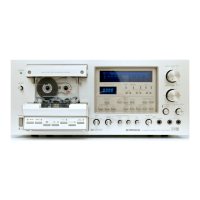
Do you have a question about the Pioneer CT-F1250 and is the answer not in the manual?
| Type | 3-head, single compact cassette deck |
|---|---|
| Track System | 4-track, 2-channel stereo |
| Tape Speed | 4.76 cm/s |
| Wow and Flutter | 0.03% (WRMS) |
| Frequency Response | 20Hz to 20kHz (Metal tape) |
| Total Harmonic Distortion | 0.8% |
| Tape Type | Metal |
| Outputs | Line |
| Heads | 3 |
Confirm voltage, check connections, follow safety warnings.
Details on color-coded wires for the UK power plug.
Tape calibration, dual capstan, three-head system for better sound.
Feather-touch buttons, digital meter, tape counter, meter selector.
Repeat playback, memory stop, memory play functions.
Procedures for changing line voltage and replacing fuses.
Pitch control, Dolby NR, Rec mute, timer, MIC/LINE mixing.
Power switch, dust cover, tape marker, quartz lock indicator.
Pitch control knob for speed adjustment.
Mic/line input controls, monitor switch.
Output level controls, tape counter.
MIC and Headphone jack functions and precautions.
Dolby NR/Multiplex filter switch functions.
Bias, Level, EQ knobs and Mode Selector.
REC MUTE, Play, Rec, Pause, Stop button functions.
Tape counter, Dolby NR, Memory/Repeat, Tape indicators.
Level meter, brightness selectors, meter mode switches.
Memory/Repeat switches, Timer start switches.
Shows output/input terminals and voltage selector for rear panel.
Proper grip for unplugging, avoiding wet hands.
Avoid opening unit, keep metal objects away from heads.
How to insert and remove cassette tapes correctly.
Using REW, FF, STOP, PLAY, PAUSE buttons.
Auto-stop function and tape slack take-up mechanism.
Standard, low-noise, and high-performance tape types.
Table of recording times for different cassette designations.
Checking for tape slack and using erasure prevention tabs.
Setting tape selector and mode to OFF for standard use.
Ensure tape can be recorded, check erasure tabs.
Steps to follow for tape calibration adjustment.
Step-by-step guide for BIAS, LEVEL, EQ adjustments.
How to operate mode selector and calibration knobs.
Adjusting EQ or setting knobs to center position for problems.
Setting switches, controls before playback.
Steps to start, stop, and pause playback.
Using output controls for volume and monitoring.
Using repeat switches for continuous playback.
Using memory functions for tape indexing.
Important notes on repeat and memory functions.
Setting switches, inserting tape, tape calibration.
Adjusting input levels and monitoring sound.
Steps to start, monitor, and stop recording.
Adjusting levels for signal-to-noise ratio and distortion.
Using monitor switch, Dolby NR, and rec mute.
Erasing recordings and using multiplex filter.
Connecting and mixing microphone inputs.
Cleaning heads, capstan, pinch rollers.
Cleaning front panel and demagnetizing heads.
Automatic recording using an optional timer.
Automatic playback by timer for waking up.
Simultaneous recording and tape duplicating.
How Dolby NR reduces tape hiss and its effects.
Recording level, program source, playback usage.
Advice on locations to avoid for optimal performance.
Motors, heads, frequency response, wow/flutter.
Sensitivity, output levels, harmonic distortion.
Subfunctions, dimensions, weight, power requirements.
Table of common issues like tape not running, weak sound, no playback.
How to mount the unit in an EIA standard rack.